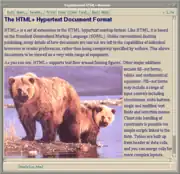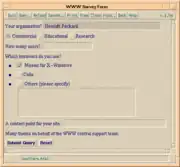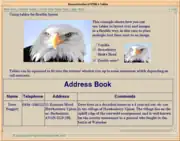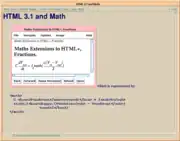_screenshot.png.webp) Arena on www | |
| Original author(s) | Dave Raggett (1992–1994),[1] Håkon Wium Lie, Henrik Frystyk Nielsen, Yves Lafon |
|---|---|
| Developer(s) | CERN/W3C[1] Yggdrasil Computing |
| Initial release | pre 1993 Public: 0.91 24 October 1994[2] |
| Final release | |
| Written in | C |
| Operating system | NeXT,[5] Linux,[6][7] Unix[7] SunOS,[6] Solaris,[6] SGI,[6] DEC,[8] FreeBSD,[9] X11(X)[8][10] |
| Available in | English |
| Type | Web browser, HTML editor |
| License | W3C,[8] some parts GPL[11] |
| Website | www |
The Arena browser (also known as the Arena WWW Browser)[12][13] was one of the first web browsers for Unix.[11][14] Originally begun by Dave Raggett in 1993, development continued at CERN and the World Wide Web Consortium (W3C) and subsequently by Yggdrasil Computing. Arena was used in testing the implementations for HTML version 3.0,[15] Cascading Style Sheets (CSS), Portable Network Graphics (PNG),[3] and libwww.[1][6][16] Arena was widely used and popular at the beginning of the World Wide Web.
Arena, which predated Netscape Navigator and Microsoft's Internet Explorer, featured a number of innovations used later in commercial products.[17] It was the first browser to support background images, tables, text flow around images, and inline mathematical expressions.[1][18][19]
The Arena browser served as the W3C's testbed browser from 1994 to 1996 when it was succeeded by the Amaya project.[8][20][21]
History
Dave Raggett, realizing that there were not enough working hours left for him to succeed at what he felt was an immensely important task, continued writing his browser at home. There he would sit at a large computer that occupied a fair portion of the dining room table, sharing its slightly sticky surface with paper, crayons, Lego bricks and bits of half-eaten cookies left by the children.
-Web Browser History[19]
In 1993, Dave Raggett, then at Hewlett-Packard (HP) in Bristol, England devoted his spare time to developing Arena on which he hoped to demonstrate new and future HTML specifications. Development of the browser was slow because Raggett was the lone developer and HP, which like many other computer corporations at the time, was unconvinced that the Internet would succeed and thus did not consider investing in web browser development.[22] Raggett demonstrated the browser at the first World Wide Web Conference in Geneva, Switzerland in 1994[23] and the 1994 ISOC conference in Prague[24] to show text flow around images, forms, and other aspects of HTML later termed as the HTML+ specification.[1] Raggett subsequently partnered with CERN, to develop Arena further as a proof of concept browser for this work. Using the Arena browser, Dave Raggett, Henrik Frystyk Nielsen, Håkon Wium Lie and others demonstrated text flow around a figure with captions, resizable tables, image backgrounds, HTML math, and other features.[8][19][25][26][27][28] At the Web World conference in Orlando, in early 1995, Raggett demonstrated the different new features of Arena.[1]
Since July 1994 Lie was integrating libwww and CSS and helping Raggett.[29][30] In October 1995, Yves Lafon joined the team for a year to provide support for HTML form and style sheet development.[31][32]
Arena was originally released for Unix, and although there was talk of a Windows and Macintosh port,[33][34][35] neither came to fruition.[14][16]
Despite its time of development, Arena is in certain areas a relatively modern browser; because it functioned as a testbed,[36] it saw the implementation of new technologies long before they became mainstream, e.g. CSS. Arena implemented many elements of the HTML3 and HTML3.2 specification including math elements[6] that were deprecated in HTML4, HTML tables,[8] and experimental style sheets.[8]
W3C pre-Beta
The development history and the source code of earlier software builds are not well documented,[37][38][39][40] because the developers did not want to distribute the source code until they considered the browser to be stable.[41] In version 0.95, support for inline JPEG images was added.[42] In version 0.96, support was added for the FTP, NNTP, and Gopher protocols, as well as experimental support for CSS.[8][43] In Arena 0.98 Dave Beckett added full PNG support.[5]
W3C Beta-1
The W3C published 5 versions of the Arena beta-1 between 27 November 1995 and 8 February 1996 improving 16-bit operating system support[44] and reimplementing CSS (which was still a Working Draft).[44] The W3C and the INRIA, a French national research institution, gave additional funding to develop CSS.[45][46][47][48] To better implement and write CSS, an experimental style sheet for Arena was developed. On 22 May 1996, the W3C announced that Amaya will replace Arena as their new testbed and that the W3C was looking for a new maintainer because the W3C did not have the resources for two testbeds.[49]
W3C Beta-2
Beta-2 had two builds (beta-2a: 28 February 1996 and beta-2b: 21 March 1996) and introduced a new API for communicating with other applications.[52][53][54] Also, the internal component libwww was updated to version 4.[52] OMRON Corporation developed an internationalized version that could display Chinese, Korean and Japanese characters in one page.[55] OMRON's Arena supports both ISO-2022 and Unicode. It is able to guess the charset parameter automatically if charset parameter isn't specified in Content-Type field.[51][56][57]
W3C Beta-3
Beta-3a released on 14 August 1996 and Beta-3b released on 16 September 1996 introduced support for the Linux operating systems on m68k and DEC Alpha.[58] CSS 1 support was enhanced[58] and the internationalized version was also updated.[51] Between the two beta-3 releases the W3C was already looking at a new testbed[8] and switched later to the Amaya browser.[58] Beta-3 was the last involvement of the W3C in the development of Arena. On 17 February 1997, Yggdrasil Computing took over the role of developing the browser.[9]
Yggdrasil phase

On 17 February 1997, the W3C approved Yggdrasil to coordinate future development of Arena.[59] Development was taken over by Yggdrasil, with the idea to turn Arena into an open source X Window System browser licensed under the GNU General Public License.[60] Yggdrasil licensed an X emulator from Pearl Software to port Arena to Windows,[9] although these builds were never released. Yggdrasil did not provide any official binaries at this time, because they did not want to expand the community with alpha-quality software.[11] Although users would be able to run Arena by compiling it from the published source code, volunteers created unofficial finished binaries.[61] Yggdrasil had planned to implement browsing features that were already standard in competitive web browsers,[11][61] which resulted in the new bookmarks feature in version 0.3.18 on 7 April 1997.[4]
Development stopped in late 1998, with the final release being on 25 November 1998.[3][note 1] The W3C did not consider demonstration projects to be high priority, and thus, the Arena browser was entirely shut down in favor of outside Linux-community development.[62]
Features
Arena supported the following features:
- HTML3.0 – the HTML3.2 standard predecessor, which includes
<math>, tables, forms, etc.[11][63][64] - CSS1[11][65]
- style sheet editing. This very experimental style sheet editor was implemented using forms[11]
- editing remote HTML pages[14]
- MIME (reads your mailcap file and applies the rules)[11]
- direct access to WAIS engines (optionally)[11]
- HTTP 1.1 proposed by RFC 2068 (formerly called HTTP-NG)[11][66]
- HTML editing with external editor[11]
- external client communication (API[53] and HTML "mailto:" scheme[11])
- PNG, JPEG,[42][43] GIF[11][67] (but not animated GIFs)[68]
- Bookmarks (since 0.3.18)[4]
- full XPM (since 0.3.33) and full XBM (since 0.3.34)[4][69]
- Java applets (since 0.3.39)[4]
- HTML Table support[70]
- HTML Math equations[71][72][73]
- Link rendition[74]
- FTP,[43][69] NNTP,[43] Gopher[43]
Technical
Arena was built using the multi-threaded library of common code called the W3C Reference Library, now called libwww.[70][75][76] Originally, the Arena browser was built on top of Xlib as Raggett considered the programming manuals for Motif and other X libraries to be rather daunting.
Version numbering
Arena has three different systems for the version numbering. The W3C pre-beta phase uses a system of numbers up to 0.99, which indicated that these builds were in alpha-quality and the browser could have new features. The beta phase changed the version numbering to a system consisting of the word "Beta-" beta followed by a number. After the beta-phase, the final product would have the version 1.0. After Yggdrasil overtook the development, the development status was changed from the W3C beta builds back to alpha, implying that the Arena browser wasn't yet ready for release.[11] The beta-3e version numbering then became 0.3.5 in GNU style[11][77] Development remained in alpha stage until 0.3.62, and never again advanced to beta.
Criticism
Although Arena ran well,[78] there were inconsistent reports about the speed of Arena.[68][78]
The biggest problems were that Arena couldn't handle forms,[68][78] and that the PNG support was broken from version 0.3.07 on. Earlier Arena releases had full alpha-channel support, but only with using Arena's own "sandy" background pattern.[3][68][79] The animated GIFs extension – presented by Netscape in March 1996 – did not work properly.[68]
Other problems included rendering problems with tables,[68] and the lack of integration of so-called extended HTML code, i.e. the <BG COLOR>-tag[68] and the <DIV ALIGN>-tag.[68]
Earlier versions of Arena (until 0.3.26 (01.06.97))[80] did not support the email MIME.[81]
Screenshots
 HTML+ document rendered
HTML+ document rendered HTML form
HTML form HTML+ table
HTML+ table HTML3.1 and math
HTML3.1 and math HTML3.0 table
HTML3.0 table
Timeline of releases
Notes
- ↑ Because the official page is no longer online, the older source code and precompiled builds of Yggdrasil's development are no longer available, although Debian's repository archive contains the three newest builds.
References
- 1 2 3 4 5 6 Raggett, Dave. "Dave Raggett's Bio". World Wide Web Consortium. Archived from the original on 24 February 2021. Retrieved 11 June 2010.
- ↑ "www-talk: Arena 0.91 available". The World Wide Web History Project. Retrieved 30 October 2023.
- 1 2 3 4 Roelofs, Greg (14 March 2009). "Browsers with PNG Support". libpng. Archived from the original on 22 August 2017. Retrieved 3 June 2010.
- 1 2 3 4 5 QingLong, Lu (24 March 1998). "Arena change history". Yggdrasil Computing. Archived from the original on 28 February 2003. Retrieved 3 June 2010.
- 1 2 Lie, Håkon Wium (23 November 1995). "Welcome to Arena 0.98". World Wide Web Consortium. Archived from the original on 2 January 2009. Retrieved 11 June 2010.
- 1 2 3 4 5 6 Lie, Håkon Wium (15 June 1996). "Arena: Frequently Answered Questions". World Wide Web Consortium. Archived from the original on 21 July 2017. Retrieved 3 June 2010.
- 1 2 Evans, Peter (7 September 2003). "Optimized for no one, but pretty much OK with ..." hoary.org. Archived from the original on 12 April 2010. Retrieved 2 June 2010.
- 1 2 3 4 5 6 7 8 9 Lafon, Yves; Lie, Håkon Wium (15 June 1996). "Welcome to Arena". World Wide Web Consortium. Archived from the original on 27 March 2021. Retrieved 6 June 2010.
- 1 2 3 Richter, Adam. "Yggdrasil approved by The World Wide Web Consortium to develop Arena Web Browser" (Press release). Yggdrasil Computing. Archived from the original on 9 November 2002. Retrieved 4 June 2010.
- ↑ Connolly, Dan (17 August 1995). "World Wide Web Client Software products". World Wide Web Consortium. Archived from the original on 16 June 2010. Retrieved 17 June 2010.
- 1 2 3 4 5 6 7 8 9 10 11 12 13 14 15 QingLong, Lu. "The Arena Web Browser". Yggdrasil Computing. Archived from the original on 5 February 2003. Retrieved 6 June 2010.
- ↑ "Die Pakete" (PostScript). Scientific Linux. 1998. Archived from the original on 3 March 2016. Retrieved 11 October 2021.
- ↑ "SuSE Linux 6.4 (i386) - March 2000 "arena"". SUSE Linux distributions. 14 March 2000. Archived from the original on 8 March 2012. Retrieved 14 June 2010.
- 1 2 3 "Web working group - Minutes "Navigation, services and interoperability" session". World Wide Web Working group. Centrum Wiskunde & Informatica. Archived from the original on 11 June 2019. Retrieved 9 June 2010.
- ↑ Raggett, Dave (28 March 1995). "HyperText Markup Language Specification Version 3.0". HTML 3.0 Internet Draft Expires in six months. World Wide Web Consortium. Archived from the original on 14 March 2010. Retrieved 17 June 2010.
- 1 2 Ablan, Jerry; Yanoff, Scott (March 1996). Web site administrators survival guide. Sams.net. p. 553. ISBN 978-1-57521-018-6. Archived from the original on 9 June 2019. Retrieved 22 July 2016.
- ↑ Hughes, Phil (1 May 1997). "Linux and Web Browsers". Linux Journal (37). Archived from the original on 20 August 2017. Retrieved 26 August 2010.
- ↑ Lilly, Paul (19 August 2009). "Surfing Since 1991: The Evolution of Web Browsers - Page 2". Maximum PC. p. 2. Archived from the original on 24 April 2015. Retrieved 9 June 2010.
- 1 2 3 Kmiec, Michael; Raggett, Dave; Lam, Jenny; Alexander, Ian W. (1998). "Chapter 2 - A history of HTML". Raggett on HTML 4. Boston: Addison Wesley Longman Limited. ISBN 978-0-201-17805-0. Retrieved 26 August 2010.
- ↑ Bowers, Neil; Canon Research Centre Europe. "Weblint: Just Another Perl Hack". CiteSeerX 10.1.1.54.7191.
- ↑ Lie, Håkon Wium; Bos, Bert (April 1997). Cascading style sheets: designing for the Web. Addison Wesley Longman. p. 263. ISBN 9780201419986. Retrieved 9 June 2010.
- ↑ Berners-Lee, Tim (1993–1994). "A Brief History of the Web". World Wide Web Consortium. Archived from the original on 29 December 2010. Retrieved 24 August 2010.
- ↑ Cailliau, Robert (2 June 1994). "WWW94 -- Preliminary Proceedings". CERN. Archived from the original on 8 May 2018. Retrieved 21 July 2010.
- ↑ "INET94 Proceedings". ISOC. 11 March 1997. Archived from the original on 21 July 2010. Retrieved 21 July 2010.
- ↑ Stewart, Bill. "Web Browser History". Living Internet. Archived from the original on 20 January 2011. Retrieved 2 June 2010.
- ↑ Okin, J. R. (30 September 2005). The information revolution: the not-for-dummies guide to the history, technology, and use of the World Wide Web. Ironbound Press. p. 94. ISBN 978-0-9763857-3-8. Retrieved 9 June 2010.
- ↑ Raggett, Dave (19 January 2010). "Curriculum Vitae/Résumé for Dave Raggett". World Wide Web Consortium. Archived from the original on 27 May 2010. Retrieved 17 June 2010.
- ↑ Raggett, Dave (7 November 1997). "Dave Raggett's Work at W3C". World Wide Web Consortium. Archived from the original on 4 March 2016. Retrieved 17 June 2010.
- ↑ Nielsen, Henrik Frystyk (7 June 2002). "Libwww Hackers". World Wide Web Consortium. Archived from the original on 2 December 2009. Retrieved 6 June 2010.
- ↑ Lie, Håkon Wium; Bos, Bert. "Chapter 20 - The CSS saga". World Wide Web Consortium. Archived from the original on 19 June 2010. Retrieved 23 June 2010.
- ↑ "Yves Lafon". World Wide Web Consortium. Archived from the original on 24 June 2010. Retrieved 17 June 2010.
- ↑ "The W3C Team: Technology and Society". World Wide Web Consortium. 18 July 2008. Archived from the original on 28 May 2010. Retrieved 17 June 2010.
- ↑ Lie, Håkon Wium (10 March 1995). "README". World Wide Web Consortium. Archived from the original on 10 July 2019. Retrieved 10 July 2019.
- ↑ Lie, Håkon Wium (15 February 1995). "README". World Wide Web Consortium.
- ↑ Lie, Håkon Wium (24 July 1995). "README". World Wide Web Consortium. Archived from the original on 10 July 2019. Retrieved 10 July 2019.
- ↑ Rae A. Earnshaw; John A. Vince (1997). The Internet in 3D: information, images, and interaction. Academic Press. p. 24. ISBN 9780122277368.
- ↑ Raggett, Dave; Lie, Håkon Wium; Nielsen, Henik Frystyk; Phill (24 October 1994). "Arena 0.9". World Wide Web Consortium. Archived from the original on 5 November 2012. Retrieved 12 June 2010.
- ↑ Raggett, Dave; Lie, Håkon Wium; Nielsen, Henik Frystyk; Phill (24 July 1995). "Arena 0.93 is obsolete!". World Wide Web Consortium. Archived from the original on 5 November 2012. Retrieved 12 June 2010.
- ↑ Raggett, Dave; Lie, Håkon Wium; Nielsen, Henik Frystyk; Phill (24 July 1995). "Arena 0.94 is obsolete!". World Wide Web Consortium. Archived from the original on 5 November 2012. Retrieved 12 June 2010.
- ↑ Raggett, Dave; Lie, Håkon Wium; Nielsen, Henik Frystyk; Phill (24 July 1995). "Arena 0.95 is obsolete!". World Wide Web Consortium. Archived from the original on 5 November 2012. Retrieved 12 June 2010.
- ↑ Wirzenius, Lars (25 January 1995). "Arena (www-browser) v0.94 uploaded to sunsite". Massachusetts Institute of Technology. Archived from the original on 16 July 2011. Retrieved 8 June 2010.
- 1 2 Lie, Håkon Wium (22 February 1995). "Arena: Frequently Answered Questions". World Wide Web Consortium. Archived from the original on 5 November 2012. Retrieved 11 June 2010.
- 1 2 3 4 5 Raggett, Dave; Lie, Håkon Wium; Nielsen, Henik Frystyk; Phill. "Arena 0.96". World Wide Web Consortium. Archived from the original on 1 December 2011. Retrieved 11 June 2010.
- 1 2 Lafon, Yves; Lie, Håkon Wium (2 July 1995). "Welcome to Arena beta-1". World Wide Web Consortium. Archived from the original on 14 March 2010. Retrieved 6 June 2010.
- ↑ Lie, Håkon Wium (22 May 1996). "CSS editors". INRIA. Archived from the original on 30 December 1996. Retrieved 6 June 2010.
- ↑ Lie, Håkon Wium; Henrik Frystyk Nielsen (4 September 1995). "Style sheets: a case study". World Wide Web Consortium. Archived from the original on 25 December 2009. Retrieved 6 June 2010.
- ↑ Lafon, Yves (15 November 1995). "Style Example". World Wide Web Consortium. Archived from the original on 31 January 2010. Retrieved 6 June 2010.
- ↑ Peyton, Charles (9 February 1996). "This is a Level 1 heading in an HTML 3 Test Document". United States Navy. Archived from the original on 11 October 1997. Retrieved 6 June 2010.
- ↑ Lie, Håkon Wium (22 May 1996). "Arena: Activity". World Wide Web Consortium. Archived from the original on 5 November 2012. Retrieved 11 June 2010.
- ↑ "The internal structure of Arena". 1 February 1996. Archived from the original on 21 July 2007.
- 1 2 3 Mukaigawa, Shin'ichi (18 April 2000). "Arena i18n: Extended Arena by OMRON". OMRON. Archived from the original on 21 July 2007. Retrieved 3 June 2010.
- 1 2 Lafon, Yves; Lie, Håkon Wium (6 June 1996). "Welcome to Arena beta-2". World Wide Web Consortium. Archived from the original on 1 December 2009. Retrieved 6 June 2010.
- 1 2 Lafon, Yves (5 July 1996). "Arena beta-2 client communication". World Wide Web Consortium. Archived from the original on 11 September 2010. Retrieved 6 June 2010.
- ↑ Nahaboo, Colas (24 July 2000). "The browser-history web page". nahaboo.net. Archived from the original on 6 April 2010. Retrieved 6 June 2010.
- ↑ Kreutzmann, Dr. Helge (6 January 2010). "WWW-Browsers for Linux". helgefjell.de. Archived from the original on 26 July 2020. Retrieved 3 June 2010.
- ↑ Mukaigawa, Shin'ichi (3 February 1996). "A国際化WWWブラウザの設計と実装 --- i18n Arena" [Design and Implementation of I18N WWW Browser --- i18n Arena] (in Japanese). OMRON. Archived from the original on 13 October 2006. Retrieved 7 June 2010.
- ↑ "Code Converter of Arena". OMRON. 9 April 1996. Archived from the original on 21 July 2007. Retrieved 2 July 2010.
- 1 2 3 Lafon, Yves; Lie, Håkon Wium (6 June 1996). "Welcome to Arena beta-3". World Wide Web Consortium. Archived from the original on 28 September 2020. Retrieved 6 June 2010.
- ↑ Richter, Adam J. "Yggdrasil approved by The World Wide Web Consortium to develop "Arena" Web Browser". Linux Gazette. Archived from the original on 16 June 2010. Retrieved 26 August 2010.
- ↑ "Linux WWW HOWTO : Setting up WWW client software". The Linux Documentation Project. Archived from the original on 7 June 2011. Retrieved 7 June 2010.
- 1 2 QingLong, Lu. "Arena Frequently Asked Questions". Yggdrasil Computing. Archived from the original on 28 February 2003. Retrieved 6 June 2010.
- ↑ Khare, Rohit (19 March 1998). "The Evolution of the World Wide Web Consortium". Archived from the original on 8 June 2011. Retrieved 7 June 2010.
- ↑ "MAPS: Minutes and APpendiceS" (PDF) (in Dutch). Nederlandstalige TEX Gebruikersgroep. 5 September 1995. Archived (PDF) from the original on 24 July 2011. Retrieved 10 June 2010.
- ↑ Kelly, Brian (1994). "Running A World-Wide Web Service". handbook. AGOCG (Advisory Group on Computer Graphics). Archived from the original on 4 October 2011. Retrieved 9 August 2011.
- ↑ Lie, Håkon Wium (4 March 1997). "Web Style Sheets". World Wide Web Consortium. Archived from the original on 5 November 2012. Retrieved 17 June 2010.
- ↑ Spero, Simon. "Progress on HTTP-NG". World Wide Web Consortium. Archived from the original on 10 July 2010. Retrieved 11 June 2010.
- ↑ Roelofs, Greg (1 April 1997). "History of the Portable Network Graphics (PNG) Format". Linux Journal (36). Archived from the original on 7 June 2011. Retrieved 26 August 2010.
- 1 2 3 4 5 6 7 8 "The Results". ThreeToad Multimedia. Archived from the original on 24 February 1999. Retrieved 15 June 2010.
- 1 2 Raggett, Dave; Lie, Håkon Wium; Nielsen, Henik Frystyk; Phill (16 January 1995). "Arena 0.92 is obsolete!". World Wide Web Consortium. Archived from the original on 5 November 2012. Retrieved 11 June 2010.
- 1 2 "Computing and The Internet". Broward College. Archived from the original on 13 September 2002. Retrieved 7 June 2010.
- ↑ Cross, Graeme (27 July 1998). "Web browsers for Linux". University of Leeds. Archived from the original on 19 April 2010. Retrieved 7 June 2010.
- ↑ "Some Free Software". Saugus.net. Archived from the original on 6 July 2010. Retrieved 15 June 2010.
- ↑ "Running A WWW Service - 3 World-Wide Web Browsers". Advisory Group on Computer Graphics. Archived from the original on 15 June 2017. Retrieved 15 June 2010.
- ↑ Berners-Lee, Tim. "Frequently asked questions by the Press - Tim BL". World Wide Web Consortium. Archived from the original on 3 October 2018. Retrieved 9 June 2010.
- ↑ Hughes, Phil (December 1995). "Stop the Presses: Just Browsing". Linux Journal. 1995 (20es): 323–328. CiteSeerX 10.1.1.309.7741. doi:10.1109/TIT.1987.1057315. ISSN 1075-3583. Archived from the original on 29 October 2021. Retrieved 5 June 2010.
- ↑ Baum, Steven K. (13 October 1998). "Wn-Wz". Texas A&M University. Archived from the original on 30 June 2012. Retrieved 15 June 2010.
- ↑ QingLong, Lu (24 March 1998). "Arena change history". Yggdrasil Computing. Archived from the original on 28 February 2003. Retrieved 3 June 2010.
beta-3e aka 0.3.05 (12.12.96)
- 1 2 3 "Letters to the Editor". Linux Journal (24). 1 April 1996. Archived from the original on 7 June 2011. Retrieved 26 August 2010.
- ↑ Roelofs, Greg (14 March 2009). "PNG Transparency". libpng. Archived from the original on 25 July 2010. Retrieved 10 June 2010.
- ↑ Kahan, José (7 June 2002). "Change History of libwww". World Wide Web Consortium. Archived from the original on 20 June 2010. Retrieved 30 May 2010.
- ↑ Scrafford, Roger (1 December 1995). "Caldera Network Desktop v 1.0". Linux Journal (20). Archived from the original on 13 August 2012. Retrieved 26 August 2010.
Bibliography
- Raymond, Eric S. (26 March 1997). "The Linux XFree86 HOWTO". Archived from the original on 20 July 2011. Retrieved 7 June 2010.
- Ford, Andrew (1995). Spinning the web: how to provide information on the Internet. International Thomson Pub. p. 6. Retrieved 9 June 2010.
- Raggett, Dave; Lam, Jenny; Alexander, Ian (April 1996). HTML 3: electronic publishing on the World Wide Web. Addison-Wesley. ISBN 978-0-201-87693-2. Archived from the original on 19 March 2015. Retrieved 22 July 2016.
- Flynn, Peter (1995). The World Wide Web handbook: a guide for users, authors, and publishers. International Thomson Computer Press. ISBN 978-1-85032-205-4. Archived from the original on 19 March 2015. Retrieved 22 July 2016.
- Reilly, Edwin D. (2003). Milestones in computer science and information technology. Greenwood Publishing Group. p. 33. ISBN 978-1-57356-521-9. Retrieved 9 June 2010.
Further reading
- Ball, Bill; Smoogen, Stephen (March 1998). Sams' teach yourself Linux in 24 hours. Sams Pub. p. 202. ISBN 978-0-672-31162-8. Retrieved 4 June 2010.
- Kressin, Mark (1997). The Internet and the World Wide Web: a time-saving guide for new users. Prentice Hall PTR. ISBN 978-0-13-493743-4. Archived from the original on 19 March 2015. Retrieved 22 July 2016.
